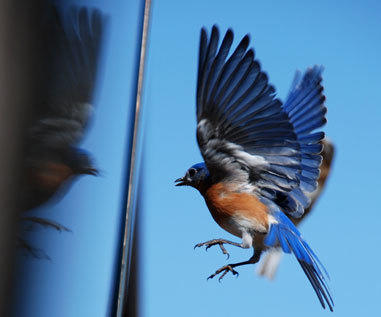Window Strikes

Birds will strike a window for various reasons. They hit the window mostly when they are panicked or during territorial chases. Occasionally, a bird will not recognized a window and mistake the reflection of sky or yard for safe passage. Birds that collide with glass while in free-flight are rarely just “stunned”, even if they are able to fly away after a period of recovery. Most suffer internal injuries and should be, if possible, examined by a licensed wildlife rehabber.
Window Attacks
Sometimes birds see their reflection in a window or even a car mirror and will attack the perceived intruder by pecking at the window or repeatedly dashing at the window. They are trying to chase the competitor out of their territory. This territorial behavior often happens during nesting season with cardinals, bluebirds, robins, mockingbirds and other birds. You can deter the attacks by removing the reflection.
Because this is a seasonal behavior, it can be prevented with temporary measures such as covering the outside of the window with soap, newspaper, tempra paint or a snow-type spray. Also, shining a bright light through the window from inside during the day may help eliminate any reflections on the outside.
The best cure is to make your windows bird-safe.
You can make your windows safer with one or more of the following steps:
- Place bird feeding stations within three feet (1 meter) of the window or beyond ten feet (3 meters). Within three feet, birds ‘fleeing’ the feeder area will not have built up enough speed to injure themselves if they strike the window. Beyond ten feet, birds will have enough time to spot and avoid the window.
- Set up a window feeder. It will help increase the birds’ awareness of the window and provide you close views of them feeding.
Window screens are a great solution. If your windows don’t have screens, there are some netting options you can purchase to install over your windows to keep birds from injuring themselves. - Hanging vertical exterior strips across the window at 4 inch (10 cm) intervals can be a good deterrent; especially, if they are a reflective mylar ribbon or even paracord.
- Try films or other window applications that create contrast. Research indicates the key to effectiveness is having them close enough together; usually within 4 inches (10 cm) vertically and 2 inches (5 cm) horizontally.
- Interior vertical or horizontal blinds with the slats half open may make the window more visible and cut down on some bird casualties. Go outside and look to see if it is visible. If you can’t see it, the birds can’t see it. Soaping the window or using spray-snow is a good temporary solution to deter collisions until you can install a more permanent solution.
How you can help an injured bird?
If you find a bird dazed from a window collision, examine it for external injuries. If the wings are both held properly, neither dangling, and the eyes seem normal, see if it can perch in a branch unassisted. If so, leave it to recover on its own.
If the bird has a noticeable injury, get it to a wildlife rehabilitator as quickly as possible. Broken bones usually need proper attention within minutes or hours to heal properly without surgery.
Meanwhile, place it in a dark container such as a shoebox, and leave it somewhere quiet, out of reach of pets and other predators, for 15 minutes. If the weather is extremely cold, you may need to take it inside, but don’t keep the bird too warm. Do not try to give it food and water, and resist handling it. The darkness will calm the bird while it revives, which should occur within a few minutes unless it is seriously injured. Do not open the box indoors to check on it or it might escape into your house and be hard to get back out!
Take the box outside every 15 minutes or so and open it—if the bird flies off, that’s that! If it doesn’t recover in a couple of hours, take it to a wildlife rehabilitator. Remember that, technically, it is illegal to handle a migratory bird without a permit, and medically helping an injured bird requires training, so your job is just to transport the bird to a rehabilitator.
For more information, check out https://abcbirds.org/glass-collisions/why-birds-hit-glass/

